
 |
Unlimited Air Racing - Reno 2014
Text and Photos by Dan Whitney
The 51st year of Unlimited Air Racing at Reno continued last year’s trend with some of the most exciting and best racing ever! As you will see the strict enforcement of the FAA’s “not to exceed” height of 250 feet on the race course remains a major safety issue with many of the pilots. There is simply no place to go when things get tight. Rule changes and small purses again resulted in a field of only 14 Unlimited racers, the same as last year, but these racers provided buckets of exciting racing. Racing was organized so that there were two Unlimited heats each of the four days of racing, keeping everyone entertained with the colorful and loud racers. There was also plenty of drama with the racers and race crews, which got the fans really involved as they followed the exploits of their favorites.
On Monday and Tuesday there are two qualifying sessions each day for the Unlimiteds, and on Wednesday a single session. The other racing classes filling the balance of the day, making for a very busy few days as everyone prepares for the Thursday, Friday, Saturday and Sunday heat races. Monday afternoon qualifying was canceled following the tragic crash of Sport Class pilot Lee Behel in his GP-5 homebuilt V-8 powered racer Sweet Dreams. He was on the back side of the course during qualifying when the wooden racer suffered a catastrophic separation of the right wing, which caused the aircraft to immediately roll to the right and impact the ground. Lee was one of the founders of the Sport Class and was their current president. An outstanding and highly experienced pilot, Lee was well liked and his loss is deeply felt by all.
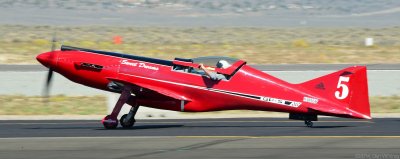 |
| Lee Behel in his V-8 powered Sport Class racer Sweet Dreams coming back from his Monday morning practice for qualifying. In 2012 he qualified at 363.233 mph, faster than several Unlimiteds! |
The Big Picture
This year’s racing excitement was the return of legendary pilot Bill “Tiger” Destefani, seven time Gold winner and owner of the famed P-51 Strega, who was going to take on his racing protégé Steven Hinton, now piloting Bob Button’s highly modified and improved P-51 Voodoo. Competing with them was some formidable competition. The modified F8F Bearcat Rare Bear appeared to be healthy and competitive, along with the Sea Fury’s 232 and Dreadnought, as well as the hot Yak Czech Mate and the vigorous P-51XR Precious Metal. A very strong field for the Unlimited Gold!
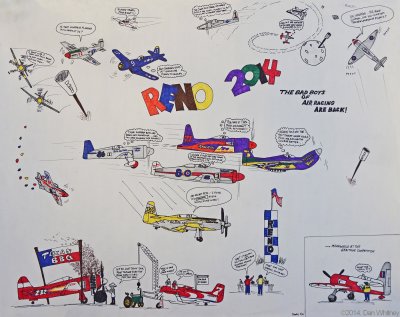 |
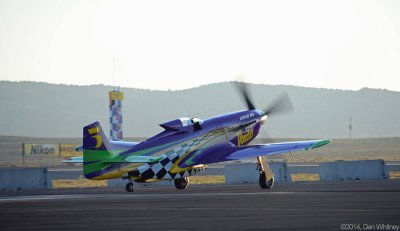 |
| This cartoon showed up in Voodoo’s pit on Saturday, before the big race with Strega. It captures, tongue in cheek, some of the events of the week leading up to the finals. | Steven Hinton taking Voodoo out for a check flight early Thursday morning. |
This year’s field had five Mustangs and five Sea Furys along with one each; Bearcat, Tigercat, Corsair and Yak. These are some really competitive airplanes, to say nothing of the pilots and crews racing them. However the trials and tribulations of racing got an early start on some of the teams’ expectations and plans.
Steven Hinton in Voodoo was again hoping for the first 500+ mph qualifying lap and flew to Reno/Stead with his special qualifying engine installed. However he never got to try it on the course as it was found to have made metal on the flight, so the team immediately swapped the special Merlin out for the similar race Merlin. Steveo qualified at the head of the pack on Monday with a speed of 479.267 mph, as there was no need to push the engine as his main competitor Strega was flying with a stock Merlin (with which he qualified at 381.048 mph), awaiting the arrival of their special racing Merlin. By the time racing began on Thursday both Voodoo and Strega had already changed an engine each.
The other major engine issue occurred with Sea Fury 232. After last year’s collapsed intake duct and resulting huge backfire during a race, the team had checked out the engine and built a new and stronger intake duct. The airplane had checked out and flown well at high speed during the winter, and so it was a surprise during Monday’s qualifying when the engine again burped and stopped running, though the propeller was turning, the number one master rod had failed and ruined the engine. Shuttle Astronaut “Hoot” Gibson did another masterful dead-stick landing, but the big bird was out for the week.
Thom Richard in Precious Metal also had issues when the big Griffon suffered ignition failure during qualifying and he had to dead-stick it as well. Fortunately the feathering system he had installed on the counter-rotating propellers worked flawlessly and he safely got the airplane back on the ground. However this meant that he did not post a qualifying time and as a consequence would have to start at the back of the Bronze field on Thursday and win every heat to work his way into the Championship Breitling Gold race on Sunday.
Weather is always a factor at an aviation event, particularly one as demanding as air racing. Basically, the week’s weather was beautiful, comfortable temperatures and blue skies for the most part. On Tuesday smoke from forest fires in northern California blew in and created a lot of low haze, though not enough to adversely affect operations. On Sunday the event dodged a bullet in that at about 3:30 pm heavy smoke came over the mountains to the south of the airfield, just before the Championship Breitling Gold race. No one paid it much attention during the ceremonial buildup to the race itself, but within 15 minutes after the racers had finished and landed the smoke from the California King Fire was so thick that the back side of the course could not be seen from the grandstands.
The Races
Thursday was the first day of Unlimited racing and began with the Bronze Heat 1. Since Precious Metal had failed to qualify Thom started on the outside of the field of four racers, three P-51s and the F4U Corsair Korean War Hero. He quickly took the lead for the six lap race and finished first at 359.366 mph, followed by the two stock Mustangs Sparky and The Rebel at 319.372 and 319.181 mph respectively, who were chased by the Corsair at 310.367 mph. Sparky and The Rebel were exciting to watch as they were all over each other throughout the race, finishing only 1/3rd of a second apart.
The following Silver Heat 1 featured five airplanes, three Sea Furys, the Tigercat, and the P-51 Strega. They started in order of their qualifying speeds, Sawbones, Strega, #924, Argonaut and the Tigercat La Patrona, and they finished in the same order. This is not to say there wasn’t some excitement, particularly since Strega now was powered by its race Merlin and Destefani needed a win in order to advance to the Gold division. As a result of the time required to install Strega’s new engine he had very little time on it and chose to throttle back after passing Sawbones early in the race. This was the first time Tiger had been in a race since 2008, and the race course layout had changed following 2011. Unfortunately he cut pylon 4 on the last lap and was penalized 12 seconds, dropping him from 425.699 mph to second place with a speed of 413.479 mph, three seconds slower than Sawbones at 416.159 mph. Consequently he was not able to advance into the Gold class.
Friday racing started with the Silver Heat 2, followed by Gold Heat 2, there was no Gold Heat 1 as the Gold racer are granted a “Bye” during the first day of competition as a result of their qualifying times. Eight racers took off for the Silver, four Mustangs, two Sea Furys, the Corsair and the Tigercat. Destefani again jumped to an early lead in Strega and quickly establish a commanding lead, certainly sufficient to cover any “12 second” penalties, should they be assessed. He ended up finishing first at 462.431 mph, more than half a lap ahead (34 seconds) of Precious Metal in second at 423.785 mph. Behind the leaders there were two other races going on: stable mates Argonaut and #924 were hard at it, finishing 3rd and 4th with 370.044 and 368.810 mph respectively (though #924 was penalized 12 seconds for a pylon cut), and the two stock Mustangs Sparky and The Rebel were fighting it out with the Corsair. Sparky finished in 5th, Korean War Hero 6th and The Rebel 7th at 319.838, 315.426 and 315.381 mph respectively. The eighth airplane was the F7F Tigercat La Patrona who Did Not Start as a result of a minor oil leak found after takeoff.
Friday’s final race was the first Gold Heat of the week. The five “Bye” racers constituted the field. Clearly they were up for the experience, for they were “saving their stuff” in that the Heat was a “parade” as they finished in the same order as they qualified; all at less than their qualifying speeds.
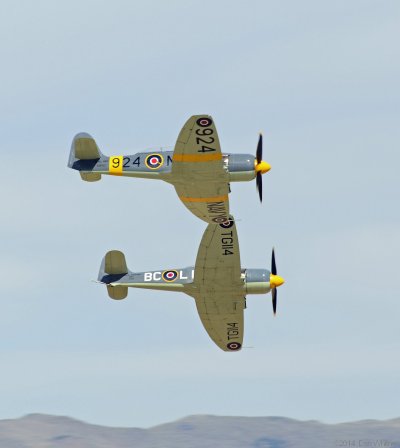 |
| Sea Furys Argonaut and #924 coming to the finish line in the Saturday Silver Heat. Korey Wells won in Argonaut at 368.987 mph, with Brian Sanders 0.028 seconds behind in #924. |
Saturday the Silver Heat 3 racers started the race in the positions in which they finished Friday, with the exception of Strega which was now in the Gold Heat 3 as a consequence of the Friday win. Precious Metal led at the start and maintained the position throughout the race, in fact Thom lapped the entire field, coming in at 437.952 mph 1 min, 13.7 sec ahead, while second place was an extremely hard fought win by Korey Wells in the R-2800 powered Argonaut over his R-3350 powered stable mate #924 flown by Brian Sanders, their speeds were 368.987 and 368.965 mph respectively! That’s racing, and they were about that close together for the entire six laps! Again there was “another” race going on behind the Sea Fury’s with the F7F Tigercat besting The Rebel and Korean War Hero with speeds of 328.668, 325.626 and 320.370 mph respectively. These three racers only completed five of the six laps as they were so far behind the win/place/show airplanes. Brant Seghetti in Sparky was a Did Not Start as he was having propeller issues.
The Saturday Gold Heat 3 may have been the “Race of the Century”, at least the 21st Century! Finally we got to see what Strega and Voodoo, two highly modified, and similarly configured Mustangs, could do against each other. Both piloted by aggressive and skilled men, Tiger with seven Reno Gold wins and Steve with four, and both willing to put it all on the line to show the other who’s first. (Some wins tabulations give Steven Hinton credit for five previous wins, however in truth there was no completed Gold Heat in 2011 and any “win” that year is due to him being the fastest qualifier.) There might be an opportunity for a rematch on Sunday, but today everything has come together and we are going to have a race! Of course it won’t only be the P-51s Voodoo and Strega, there’s also Rare Bear wanting to best them both, as well as Czech Mate and Dreadnought ready to pounce should any of them falter. Astronaut Curt Brown in Sawbones completed the field; there to keep them all honest.
Strega started in last place due to having moved up from the Silver while Voodoo used the pole advantage to move out in front and establish a commanding lead over Rare Bear. Tiger ran a high line and used his considerable power to move through the field passing Rare Bear for second position in a few laps of the six lap race. Hinton was running steady laps in the 490 mph range with Tiger not gaining much ground. Then on the last lap Tiger arced high off pylon 4 going into the “Valley of Speed” and gained considerably on Hinton as he dove on Voodoo’s tail. As they rounded pylon 8 headed for the finish line Strega was clearly gaining and the crown was going wild. As they crossed the finish line Voodoo was a prop spinner ahead, however unofficial timing had Strega at 492.541 mph and Voodoo at 492.525 mph. It was really close – Some of the best and most dramatic Unlimited racing ever.
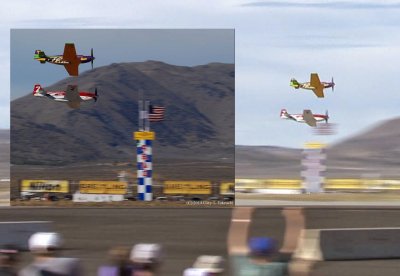 |
| Saturday Unlimited Gold Finish. The background photo is said to be an official RARA at the finish line, while the inset by Gary Takeuchi suggests Strega is ahead. Perspective is important as Voodoo was “inside” Strega, i.e. closer to the pylon. |
The excitement continued, for immediately Tiger declared a Mayday and quickly made a safe emergency landing on the back runway; his engine was done. Furthermore, the Contest Committee disqualified Tiger for not maintaining the course altitude limit; hence Voodoo was the undisputed winner. Race fans were still exuberantly excited, though disappointed that there would be no rematch in Sundays Breitling Gold final.
The rest of the field finished the Heat in the order in which they started, Rare Bear in second at 476.879 mph, Czech Mate third at 465.391, but charged with a pylon cut on lap 2 so with the 12 second penalty was credited with a speed of 450.826 mph. Fourth and fifth places went to the two Sea Furies Dreadnought and Sawbones with speeds of 434.932 and 424.592 mph respectively. All of the racers posted better speeds that they had the day before.
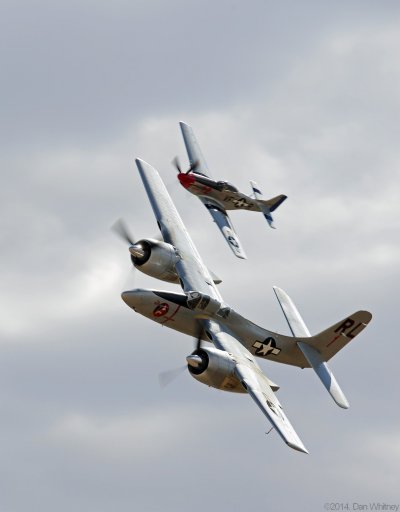 |
| In Sunday’s Silver Heat the F7F Tigercat La Patrona and P-51D Mustang The Rebel fought it out for 2nd and 3rd. When the Heat winner #924 bumped up into the Gold these guys were awarded 1st and 2nd. |
Sunday dawned clear with the promise of more great racing. The first race was the Unlimited Silver, seven laps totaling 56 miles. Five racers were in the race as Sparky had repaired its propeller; also in the field were #924, La Patrona, The Rebel and Korean War Hero. Korey Wells took the lead with #924 and stayed there for the entire race, winning at 369.988 mph. The F7F Tigercat La Patrona and The Rebel raced each other hard all the way, finishing with speeds of 342.256 and 339.276 mph respectively. They were followed by Sparky and the Corsair fighting hard to best each other with Sparky taking the position with a speed of 317.781 mph over Korean War Hero at 316.431 mph. Korey Wells decided to bump up into the Breitling Gold final, so first place went to Stu Dawson in La Patrona.
After a week of high anticipation and a fair amount of drama it was finally time for the finale: the National Championship Unlimited Breitling Gold. The weather was great, temperatures in the 80s, a slight south wind and unlimited visibility as the eight highly modified and high-powered racers lined up following the T-33 pace plane and headed for the “chute” – and the start of the race.
The first lap provided a lot of excitement as Voodoo took the course with the lead, followed by Rare Bear, Czech Mate and Precious Metal with the other four racers trailing. Almost immediately Stu Dawson in Rare Bear called a Mayday (erratic de/en-riching) and pulled up off the course, and he was followed a few seconds later by Mark Watt piloting Argonaut (oil temperature full scale). Thom Richard in Precious Metal saw an opening and was working to catch Czech Mate who was positioned in second and making a run on Voodoo, which was thwarted when Hinton pushed up the power and reestablished his margin. Dennis Sanders in Dreadnaught was holding the fourth position. Sea Furys Sawbones and #924 were in the last two positions, with Voodoo still coming on strong and preparing to lap #924. At the end of the eight lap race Hinton in Voodoo breezed to an easy win at 462.926 mph (though on his last lap he was clocked at 492.79 mph) with Czech Mate in second at 458.856 mph, his best speed of the week. The popular and colorful Precious Metal finished in 3rd, which really pleased the crowd of race fans, however after the race Thom was disqualified for having cut the east showline. This was a huge disappointment, not only for the fans but for Richard and his hardworking crew. Dennis Sanders in Dreadnaught was then moved to the 3rd place on the podium with a speed of 419.394 mph.
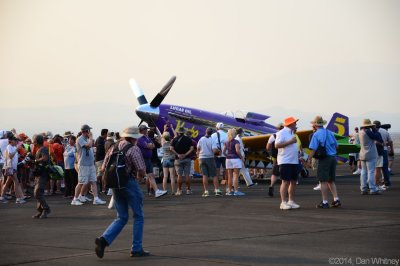 |
| Voodoo in the winners circle following Sunday’s Breitling Gold final. Note the smoke from the King Fire in California as obscured the mountains on the back side of the course. |
The Racing Airplanes
The following descriptions of each airplane are given in the order in which they qualified and tell how they fared during the week. See the table at the end of this report for speeds and placement in all of the Unlimited Heats:
#5 Voodoo, a modified P-51D similar to Strega and powered by an Allison rodded V-1650 Packard Merlin. After winning the Gold for the first time last year the racer was back with a number of racing refinements executed by Master Crewchief Bill Kerchenfaut and his skilled crew. In an effort to reduce trim drag on the airframe Bill changed the thrust-line, which required new solid metal engine mounts, thus putting the alignment to that used on the P-51A Allison powered Mustang. The stock P-51D Thrust Line of the engine is 1o 45’ above the fuselage center line, but on Voodoo it is now 0 degrees. While not obvious, the propeller was also “re-contoured” by reworking the blade profile. This moved the Center of Pressure toward the rear of the now thinner blades. These changes result in a propeller with a higher critical Mach limit, i.e., it can go faster and has less drag. A number of other refinements were made to the airframe, including construction of new carbon fiber cowling panels needed to accommodate the Thrust Line change.
On the Thursday prior to race week Voodoo was run to 100 inHgA for an overall systems check. Afterward bronze and lead flakes were found in the oil screens, suggesting that the tail of a cotter pin may have been making contact with a bearing. As a result the decision was made to pull the “qualifying” engine and install the “race” engine prior to qualifying on the coming Monday. The race engine ran fine all week.
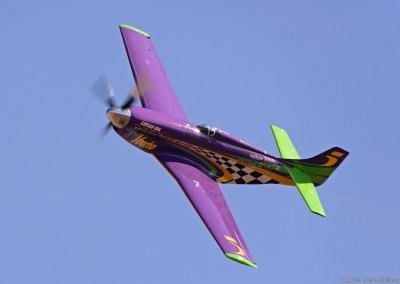 |
| Steve Hinton bringing Voodoo around #2 Pylon during Friday’s Gold Heat. |
#77 Rare Bear, the highly modified F8F-2 Bearcat powered by a Wright R-3350, was again flown by Stu Dawson and supported by crew chief Nelson Ezell. Nelson reported that he had found a number of issues with last year’s engine setup and that these had been rectified during the winter. These included:
The team continued to tweak the engine all week. After qualifying they changed carburetor jets to richen the mixture, but then after Saturday’s race EGTs were too high, with evidence of “torching” as the hot exhaust hit fresh air. Rejetted once more, but still not getting the expected torque pressure, i.e., power.
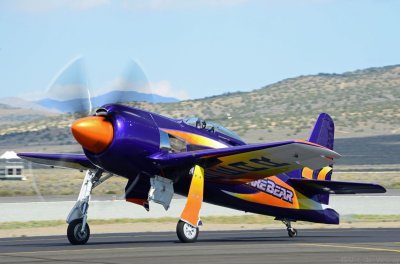 |
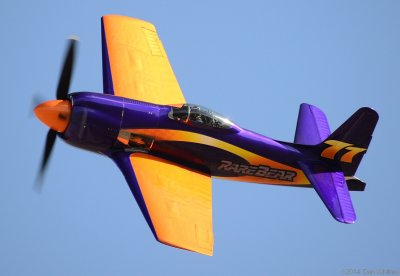 |
| Rare Bear piloted by Stu Dawson returning from his qualifying run on Monday. | Rare Bear during the Friday Gold Heat. It is believed that the orange flames from rich running are visible in the exhaust chute. |
At the start of Sunday’s Gold race the de-riching gremlin reappeared, with the engine erratically deriching/enriching, and once the engine totally quit for a moment. Stu wisely aborted and brought Rare Bear back in to race another day.
#86 Czech Mate, a highly modified Yak 11, powered by a P&W R-2800, and this year incorporating subtle refinements for its internally mounted oil coolers and ducting, as well as a new scoop on the right side of the fuselage. Some of this work was facilitated by the unfortunate ground loop that occurred at their home field after last years races. The result is a very capable airplane that is just getting better each year. Sherm Smoot qualified for the Gold with a very respectable 456.234 mph and finished second in Sunday’s Brightling Gold at 458.856 mph.
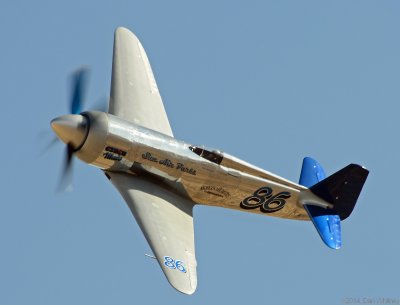 |
| Czech Mate rounding Pylon 2 during Friday Gold Heat. Sherm Smoot did well all week, finishing second in the big Yak in Sundays Breitling Gold. |
#8 Dreadnought, a modified Sea Fury T.Mk.20 powered by the mighty Pratt & Whitney R-4360. This year it was Dennis Sanders’ turn to pilot the racer as he and brother Brian alternate. Again this was the only R-4360 powered racer at Reno and finished in the money on Sunday as the 3rd place finisher at 419.394 mph after qualifying at 426.873 mph.
During the summer the airplane was involved in an unfortunate and tragic fatal mid-air collision while returning from an air show when the vertical stabilizer struck the wing of an accompanying light plane. To facilitate repairs the entire empennage was removed and replaced by a spare stock Sea Fury unit. The old empennage featured a larger vertical tail than stock, needed to provide directional stability with the R-4360 and the original propeller. That propeller was replaced with a “toothpick” bladed Skyraider propeller. This propeller results in a slightly longer takeoff run, but high speed and directional control are unchanged. Dennis likes the airplane better with the stock fin.
 |
| Dreadnought, piloted by Dennis Sanders, rounding Pylon 2 during Friday’s Gold Heat. |
#71 Sawbones, a Wright R-3350-26WA powered Sea Fury FB.11, flown by Astronaut Curt Brown. Sawbones won the Friday Silver Heat as a consequence of Strega’s pylon cut, which advanced the racer into the Gold class for the rest of the week.
In the Saturday and Sunday Gold Heats Sawbones finished just behind Dreadnaught, but missed out on getting to the podium. A good steady racer.
 |
| R-3350 powered Sawbones, piloted by Curt Brown during Thursday’s Silver Heat 1, which he won with a speed of 416.159 mph. |
#7 Strega, a highly modified P-51D Mustang competed this year with its Allison rodded Merlin having been prepared by Rick Shanholtzer and flown this year by Owner/Pilot “Tiger” Destefani. Tiger wasn’t able to qualify for the Gold Heats as his race Merlin was still enroute to Reno. Using a stock Merlin he qualified at 381.048 mph which started him in the Silver class. The race engine was installed on Wednesday, but was only able to get a couple of hours of “slow-time” before the first Silver Heat on Thursday. Although Tiger finished in first place in that heat, a pylon cut reduced him to second, so he had to run in the Silver class again on Friday. He won that Heat and was able to advance to the Gold class for Saturday’s race.
During the exciting Saturday race against Voodoo Tiger experienced a couple of “bangs” when coming around pylon 8 and heading for the finish line, this while running 3,400 rpm and 140 inHgA as he had the whole race. After the race the screens were checked for metal and a compression check was done with everything found “OK”. That evening they took the racer out on the ramp for a short runup, after which it was found that there was coolant in the oil, a sign of serious internal issues typical of a burned piston. The decision was made to not race on Sunday. Strega was out.
 |
 |
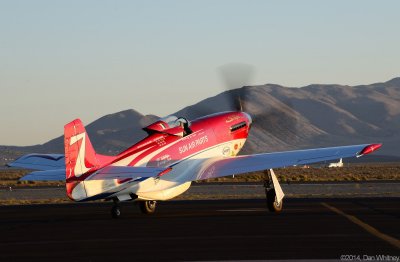 |
| Strega on the course during Friday’s Gold Heat | Installing the Rick Shanholtzer prepared race Merlin in Strega on Wednesday | Tiger Destefani heading out to slow-time his race Merlin in Strega at dawn on Thursday. |
#924 924, a Sea Fury T.Mk.20 powered by its original Bristol Centaurus engine, flown alternately by Brian Sanders and Korey Wells, who qualified the racer at 376.071 mph. These two pilots provided the fans with some really good racing, particularly on Saturday when Korey was in the Sea Fury Argonaut and Brian in #924. They finished the Silver Heat in 2nd and 3rd with Argonaut 0.028 seconds ahead of 924, posting speeds of 368.987 and 368.965 mph respectively. Last year Argonaut also won in a similar close contest with #924, then piloted by Dennis Sanders, by ¼ second at a speed of 369.488 mph. These guys like to race these big Sea Fury’s!
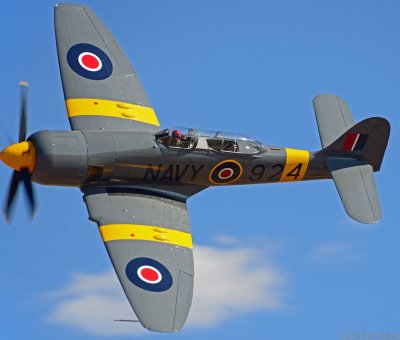 |
| It’s great to see an original Centaurus powered Sea Fury out on the course. #924 is a big airplane and an excellent example of the quality Sea Fury’s coming out of the Sanders’ shop. |
#114 Argonaut, a Sea Fury FB Mk.11 uniquely powered by a Pratt & Whitney R-2800, and flown by Korey Wells and Mark Watt. This was the forth season for the R-2800-CB3 powered Argonaut. It is still the only R-2800 powered Sea Fury and has shown to be very competitive with the stock Centaurus powered stable mate #924.
As last year, Argonaut finished second in the Saturday Silver heat. The winner Precious Metal, automatically advanced to the Gold for Sunday, leaving Argonaut as the winner. It was then decided to bump Argonaut up into the Sunday Gold with Mark Watt as pilot. On the first lap of the race the oil temperature gauge “pegged”; Mark declared a Mayday and quickly landed the big racer. With the jolt as the wheels touched the runway the gauge returned to normal, but he was out of the race. A wiring gremlin had messed things up.
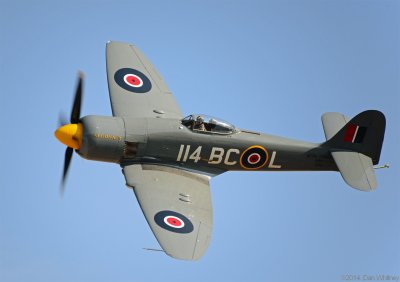 |
| Pratt & Whitney R-2800 powered Sea Fury FB 11 Argonaut during the Thursday Silver Heat 1 race. The racer was piloted by Canadian Mark Watt most of the week; note also the Canadian Air Force paint scheme. |
#1 La Patrona, the big F7F Tigercat is powered by two R-2800s. This year the Silver class racer was boasting new longer propeller spinners, said to add as much as 10 mph to its top speed, and piloted by Stu Dawson. The airplane is a real crowd pleaser and Stu had it looking good on the course. During form-up for the Friday Silver Heat Stu got a “chip” detector light on the left engine, causing him to return and land. His crew subsequently found a shorted wire to the detector, so all was well. During the Sunday Silver Heat Stu finished 2nd, behind #924, so when #924 elected to bump up into the Breitling Gold final La Patrona was declared the winner of record.
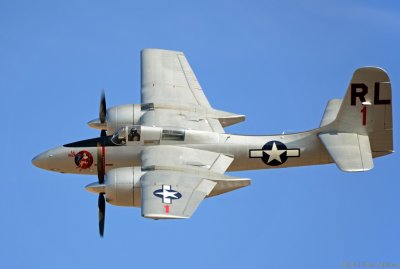 |
| The F7F is a really big airplane, with two R-2800s, it takes a lot of space on the racecourse, but it is fast as well. Stu Dawson pilots both La Patrona and the F8F Bearcat Rare Bear, which works as one is a Silver class racer and the other Gold. Note the extended and polished prop spinners. |
#44 Sparky, a stock Merlin powered P-51D flown by Brant Seghetti. Brant qualified this year at 329.638 mph, some 30 mph slower than last year. As the competition was shaping up there was just no need to post a higher speed. Sparky ran in the Bronze Heat on Thursday, and with all of the other Bronze racers, moved into the Silver class for the rest of the week. On Saturday Sparky had propeller seal issues and missed the race, but was repaired in time for Sunday’s Silver Heat where Brant finished 3rd.
#12 The Rebel, the other stock Merlin powered P-51D in this year’s completion, was qualified by Doug Matthews, who also piloted it during the Sunday Silver race, where he finished in second place his highest speed of the week, 339.276 mph. The other days John Currenti piloted The Rebel. He lost Thursday’s Heat to Sparky, but only by a quarter of a second after some very close racing.
 |
 |
| Only two stock P-51D were racing in 2014. Always fun to see. | |
#9 Korean War Hero, a stock R-2800powered F4U-4 Corsair raced by Jim Tobul. This was a first time appearance at Reno in the Unlimiteds for the Corsair and Jim, who acquitted himself very well. He ran a good line on the course and provided a lot of unique visual excitement in contrast with the other racers. Jim qualified the big bird at 315.989 mph, but finished last in all of his heat races except on Friday, when he beat The Rebel by 0.066 seconds (30 feet) in a photo finish.
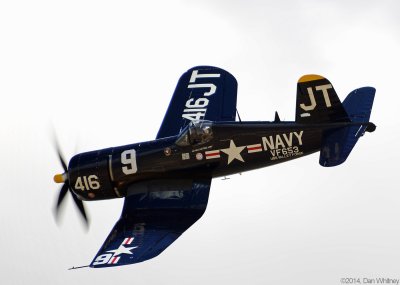 |
| Jim Tobul flying the F4U-4 Corsair Korean War Hero in Sunday’s Silver Heat where he finished 4th. It was good to see a Corsair on the course again. |
#38 Precious Metal, the highly modified P-51D powered by a Rolls-Royce Griffon 57A driving a contra-rotating propeller, was back with a modified engine and fitted with a new radiator designed in collaboration with Pete Law and the manufacturer.
The new radiator was an attempt to resolve a long standing issue with Precious Metal, for the larger Griffon engine was still being cooled by the radiator intended for the Merlin powered P-51D. As a result considerable spraybar water was required to allow the higher power; in fact, the entire 96 gallons of spraybar water would be used up after six laps, though the Breitling Gold race goes for eight laps. Pete worked with the manufacturer to provide more rows of cooling tubes and changed the coolant flowpath to a two-path arrangement. The result was a radiator having about 20% more cooling surface area, which it was hoped would allow a significant reduction in the amount of water consumed.
When Thom was on his qualifying run on Tuesday the engine quit, he quickly feathered the propellers, and made a successful dead-stick landing. The culprit was the new electronic port fuel injection system on the engine, which had worked flawlessly during testing. Initial troubleshooting indicated the likely cause was that at the high speed of qualifying the inlet ram air temperature was higher than previously encountered, causing the computer to lean the mixture to the point of cutoff. The decision was made to abandon the electronic fuel control and return to a PR-100 carburetor as had been used previously. This was a new carburetor, but it was found to be running rich at idle, resulting in excessive flames and fire around the fuselage, but there wasn’t time to get it reflowed. Instead Thom called back to Kissimmee and had the PR-100 they used last year shipped out. Fortunately it had been properly “pickled” when removed and was serviceable. This unit worked fine and the racer was again operational in time for Thursday’s Unlimited Bronze Heat, which was required since he had not officially “qualified”. Precious Metal outclassed the Bronze racers and won with a speed of 359.365 mph, one minute ahead of the second place airplane.
Thom and his crew were very busy during the week. Not only did they install the new radiator and replace the carburetor, but they also changed out the cooling air intake scoop from a stock unit to the one from the ex-racer Ridge Runner III. The stock unit was used to systematically evaluate the effectiveness of the new radiator and any improvement it provided, and separately, the effect of the improved intake scoop. Thom reported that the new radiator installation was successful and he was using only half the spraybar water as before. As for power settings, on Saturday Precious Metal ran 90 inHgA and won the Silver Heat with a speed of 437.952 mph. The plan was to run 120 inHgA during the Breitling Gold but the engine began to run rough at about 110 inHgA; so there’s still some more speed to be had.
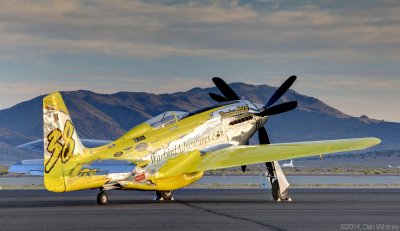 |
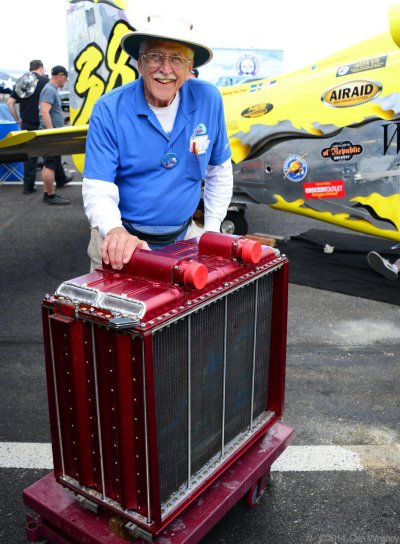 |
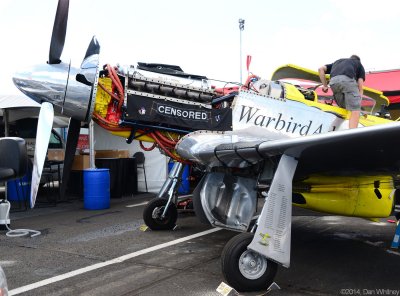 |
| The Griffon powered Precious Metal with its contra-rotating propellers makes a fine picture in Saturdays early morning light. | Pete Law shown with the new high density radiator able to fit into the original P-51D radiator space. | Precious Metal featured a “censored” curtain whenever the cowling was removed. Indicative of the amount of work the crew has done to incorporate unique changes to the Griffon. |
 |
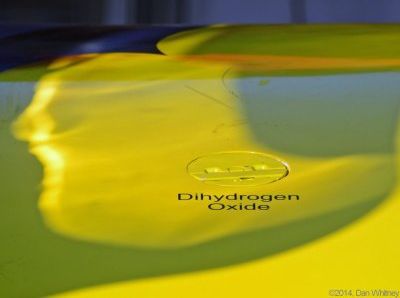 |
| Precious Metal in Friday’s Silver Heat where Thom finished in second place at 423.431 mph. You can see from the amount of water exiting the cooling scoop that he had not yet reduced the flow of spraybar water. It’s tough to dial in a new setup during a race. | Racer humor on Precious Metals spraybar water tank. |
#232 232, a modified Sea Fury FB.11 powered by a special Wright R-3350, and flown by former shuttle astronaut “Hoot” Gibson, is a stable mate of Rare Bear, both being owned by Rod Lewis. After repairing the effects of last year’s collapse of the air intake and resulting backfire, all was in readiness and big things were expected of the racer. A new stronger intake duct and repairs to the cowling and spinner, as well as a complete check of the engine, had the airplane ready to go. Hoot had the airplane up for qualifying on Monday and had just started his lap when he felt a “bump”, and then a few seconds later the engine totally failed. Hoot is expert in dead-stick shuttle landings and again executed a perfect one with 232.
After landing the oil covered airplane a dent was found in the right horizontal stabilizer leading edge, evidently the result of a piece of a valve or piston ejected from the exhaust. Inspection of the engine found that the Master Rod on the front row had broken and the pistons jammed into the tops of the cylinders. Unfortunately the racer was out for the year as a new engine is required.
 |
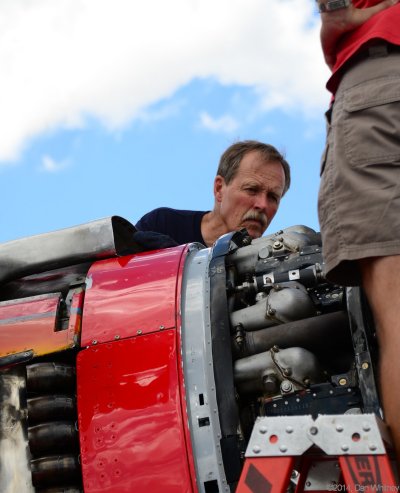 |
| #232 being towed back to the pits after blowing the R-3350 during qualifying on Monday. | #232 pilot “Hoot” Gibson inspecting his damaged engine. |
Summary
The 51st year of Reno Air Racing provided some of the most exciting and competitive racing that we have seen in years. While the number of Unlimiteds was unchanged from last year the degree of competition is better and improving. It appears that the “big boys” in the Unlimited class are definitely here to race, though the frequent rule infractions are an impediment.
There are a total of six racing divisions competing at Reno, of which the Unlimiteds are only one. The numbers of competitors and level of competition in all of them is every bit as exciting as for the Unlimiteds; the result is a week of fun and thrilling air racing by some of the most beautiful and highly tuned aircraft in the world. See you at Reno 2015!
| Race No. | Name | Aircraft Type | Pilot | Qualifying mph | Thursday mph | Friday mph | Saturday mph | Sunday mph |
|---|---|---|---|---|---|---|---|---|
| 5 | Voodoo | P-51D Mustang-Modified | Hinton, Steven Jr. | 479.267 | Bye | 473.967-G1 | 492.525-G1 | 462.926-G1 |
| 77 | Rare Bear | F8F-2 Bearcat/R-3350 | Dawson, Stewart | 476.859 | Bye | 467.497-G2 | 476.879-G2 | DNF-1G |
| 86 | Czech Mate | Yak11/R-2800 | Smoot, Sherman | 456.234 | Bye | 453.345-G3 | 450.826-G33 | 458.856-G2 |
| 8 | Dreadnought | Hawker Sea Fury/R-4360 | Sanders, Dennis | 426.873 | Bye | 414.524-G4 | 434.932-G4 | 419.394-G3 |
| 71 | Sawbones | Hawker Sea Fury/R-3350 | Brown, Curt | 423.358 | 416.159-S1 | 388.068-G5 | 424.932-G5 | 415.685-G4 |
| 7 | Strega | P-51D Mustang-Modified | Destefani, Bill “Tiger” | 381.048 | 413.479-S22 | 462.431-S1 | DQ-G4 | DNS |
| 924 | #924 | Hawker Sea Fury/Centaurus | Wells, K. & Sanders B. | 376.071 | 371.216-S3 | 368.810-S41 | 368.965-S3 | 368.503-G55 |
| 114 | Argonaut | Hawker Sea Fury/R-2800 | Watt, M & Wells, K. | 372.109 | 362.628-S4 | 370.044-S3 | 368.987-S2 | DNF-1G |
| 1 | La Patrona | F7F Tigercat | Dawson, Stewart | 357.765 | 324.429-S5 | DNS-S | 328.668-S4 | 342.256-S1 |
| 44 | Sparky | P-51D Mustang | Seghetti, Brant | 329.638 | 319.372-B2 | 319.838-S5 | DNS-S | 317.781-S3 |
| 12 | The Rebel | P-51D Mustang | Matthews &Currenti | 326.089 | 319.181-B3 | 315.381-S7 | 325.626-S5 | 339.276-S2 |
| 9 | Korean War Hero | F4U-4 Corsair | Tobul, Jim | 315.989 | 310.267-B4 | 315.426-S6 | 320.370-S6 | 316.431-S4 |
| 38 | Precious Metal | P-51XR/Griffon | Richard, Thom | DNQ | 359.365-B1 | 423.785-S2 | 437.952-S1 | DQ-G6 |
| 232 | #232 | Hawker Sea Fury/R-3350 | Gibson, Robert “Hoot” | DNQ | DNS | DNS | DNS | DNS |
|
M = Medallion, B = Bronze Heat Race, S = Silver Heat Race, G = Gold Heat Race, DNS = Did Not Start, DNF-# = Did Not Finish-lap out, DNQ = Did Not Qualify, DQ = Disqualified, BOLD = 1st Place Heat Winners, Number following Heat letter is finishing position 1 Includes 12 sec penalty for cutting Pylon 4 on lap 2. 2 Includes 12 sec penalty for cutting Pylon 4 on lap 6. 3 Includes 12 sec penalty for cutting Pylon 5 on lap 2. 4 Disqualified for not maintaining course altitude. 5 Won Sunday Silver at 369.988 mph, elected to bump up into Sunday Gold. 6 Disqualified for showline cut. |
||||||||